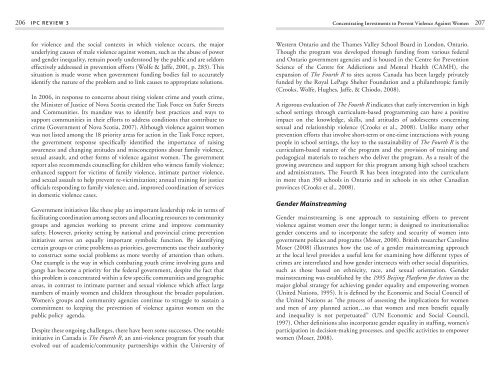Full text - Faculty of Social Sciences - Université d'Ottawa
Full text - Faculty of Social Sciences - Université d'Ottawa
Full text - Faculty of Social Sciences - Université d'Ottawa
Create successful ePaper yourself
Turn your PDF publications into a flip-book with our unique Google optimized e-Paper software.
206 IPC Review 3 Concentrating Investments to Prevent Violence Against Women 207<br />
for violence and the social con<strong>text</strong>s in which violence occurs, the major<br />
underlying causes <strong>of</strong> male violence against women, such as the abuse <strong>of</strong> power<br />
and gender inequality, remain poorly understood by the public and are seldom<br />
effectively addressed in prevention efforts (Wolfe & Jaffe, 2001, p. 283). This<br />
situation is made worse when government funding bodies fail to accurately<br />
identify the nature <strong>of</strong> the problem and to link causes to appropriate solutions.<br />
In 2006, in response to concerns about rising violent crime and youth crime,<br />
the Minister <strong>of</strong> Justice <strong>of</strong> Nova Scotia created the Task Force on Safer Streets<br />
and Communities. Its mandate was to identify best practices and ways to<br />
support communities in their efforts to address conditions that contribute to<br />
crime (Government <strong>of</strong> Nova Scotia, 2007). Although violence against women<br />
was not listed among the 18 priority areas for action in the Task Force report,<br />
the government response specifically identified the importance <strong>of</strong> raising<br />
awareness and changing attitudes and misconceptions about family violence,<br />
sexual assault, and other forms <strong>of</strong> violence against women. The government<br />
report also recommends counselling for children who witness family violence;<br />
enhanced support for victims <strong>of</strong> family violence, intimate partner violence,<br />
and sexual assault to help prevent re-victimization; annual training for justice<br />
<strong>of</strong>ficials responding to family violence; and, improved coordination <strong>of</strong> services<br />
in domestic violence cases.<br />
Government initiatives like these play an important leadership role in terms <strong>of</strong><br />
facilitating coordination among sectors and allocating resources to community<br />
groups and agencies working to prevent crime and improve community<br />
safety. However, priority setting by national and provincial crime prevention<br />
initiatives serves an equally important symbolic function. By identifying<br />
certain groups or crime problems as priorities, governments use their authority<br />
to construct some social problems as more worthy <strong>of</strong> attention than others.<br />
One example is the way in which combating youth crime involving guns and<br />
gangs has become a priority for the federal government, despite the fact that<br />
this problem is concentrated within a few specific communities and geographic<br />
areas, in contrast to intimate partner and sexual violence which affect large<br />
numbers <strong>of</strong> mainly women and children throughout the broader population.<br />
Women’s groups and community agencies continue to struggle to sustain a<br />
commitment to keeping the prevention <strong>of</strong> violence against women on the<br />
public policy agenda.<br />
Despite these ongoing challenges, there have been some successes. One notable<br />
initiative in Canada is The Fourth R, an anti-violence program for youth that<br />
evolved out <strong>of</strong> academic/community partnerships within the University <strong>of</strong><br />
Western Ontario and the Thames Valley School Board in London, Ontario.<br />
Though the program was developed through funding from various federal<br />
and Ontario government agencies and is housed in the Centre for Prevention<br />
Science <strong>of</strong> the Centre for Addictions and Mental Health (CAMH), the<br />
expansion <strong>of</strong> The Fourth R to sites across Canada has been largely privately<br />
funded by the Royal LePage Shelter Foundation and a philanthropic family<br />
(Crooks, Wolfe, Hughes, Jaffe, & Chiodo, 2008).<br />
A rigorous evaluation <strong>of</strong> The Fourth R indicates that early intervention in high<br />
school settings through curriculum-based programming can have a positive<br />
impact on the knowledge, skills, and attitudes <strong>of</strong> adolescents concerning<br />
sexual and relationship violence (Crooks et al., 2008). Unlike many other<br />
prevention efforts that involve short-term or one-time interactions with young<br />
people in school settings, the key to the sustainability <strong>of</strong> The Fourth R is the<br />
curriculum-based nature <strong>of</strong> the program and the provision <strong>of</strong> training and<br />
pedagogical materials to teachers who deliver the program. As a result <strong>of</strong> the<br />
growing awareness and support for this program among high school teachers<br />
and administrators, The Fourth R has been integrated into the curriculum<br />
in more than 350 schools in Ontario and in schools in six other Canadian<br />
provinces (Crooks et al., 2008).<br />
Gender Mainstreaming<br />
Gender mainstreaming is one approach to sustaining efforts to prevent<br />
violence against women over the longer term; is designed to institutionalize<br />
gender concerns and to incorporate the safety and security <strong>of</strong> women into<br />
government policies and programs (Moser, 2008). British researcher Caroline<br />
Moser (2008) illustrates how the use <strong>of</strong> a gender mainstreaming approach<br />
at the local level provides a useful lens for examining how different types <strong>of</strong><br />
crimes are interrelated and how gender intersects with other social disparities,<br />
such as those based on ethnicity, race, and sexual orientation. Gender<br />
mainstreaming was established by the 1995 Beijing Platform for Action as the<br />
major global strategy for achieving gender equality and empowering women<br />
(United Nations, 1995). It is defined by the Economic and <strong>Social</strong> Council <strong>of</strong><br />
the United Nations as “the process <strong>of</strong> assessing the implications for women<br />
and men <strong>of</strong> any planned action…so that women and men benefit equally<br />
and inequality is not perpetuated” (UN Economic and <strong>Social</strong> Council,<br />
1997). Other definitions also incorporate gender equality in staffing, women’s<br />
participation in decision-making processes, and specific activities to empower<br />
women (Moser, 2008).
















